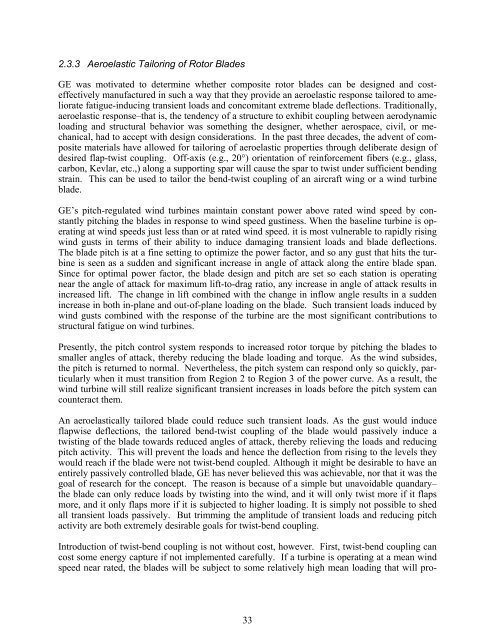Advanced Wind Turbine Program Next Generation Turbine ... - NREL
Advanced Wind Turbine Program Next Generation Turbine ... - NREL
Advanced Wind Turbine Program Next Generation Turbine ... - NREL
You also want an ePaper? Increase the reach of your titles
YUMPU automatically turns print PDFs into web optimized ePapers that Google loves.
2.3.3 Aeroelastic Tailoring of Rotor Blades<br />
GE was motivated to determine whether composite rotor blades can be designed and costeffectively<br />
manufactured in such a way that they provide an aeroelastic response tailored to ameliorate<br />
fatigue-inducing transient loads and concomitant extreme blade deflections. Traditionally,<br />
aeroelastic response–that is, the tendency of a structure to exhibit coupling between aerodynamic<br />
loading and structural behavior was something the designer, whether aerospace, civil, or mechanical,<br />
had to accept with design considerations. In the past three decades, the advent of composite<br />
materials have allowed for tailoring of aeroelastic properties through deliberate design of<br />
desired flap-twist coupling. Off-axis (e.g., 20°) orientation of reinforcement fibers (e.g., glass,<br />
carbon, Kevlar, etc.,) along a supporting spar will cause the spar to twist under sufficient bending<br />
strain. This can be used to tailor the bend-twist coupling of an aircraft wing or a wind turbine<br />
blade.<br />
GE’s pitch-regulated wind turbines maintain constant power above rated wind speed by constantly<br />
pitching the blades in response to wind speed gustiness. When the baseline turbine is operating<br />
at wind speeds just less than or at rated wind speed. it is most vulnerable to rapidly rising<br />
wind gusts in terms of their ability to induce damaging transient loads and blade deflections.<br />
The blade pitch is at a fine setting to optimize the power factor, and so any gust that hits the turbine<br />
is seen as a sudden and significant increase in angle of attack along the entire blade span.<br />
Since for optimal power factor, the blade design and pitch are set so each station is operating<br />
near the angle of attack for maximum lift-to-drag ratio, any increase in angle of attack results in<br />
increased lift. The change in lift combined with the change in inflow angle results in a sudden<br />
increase in both in-plane and out-of-plane loading on the blade. Such transient loads induced by<br />
wind gusts combined with the response of the turbine are the most significant contributions to<br />
structural fatigue on wind turbines.<br />
Presently, the pitch control system responds to increased rotor torque by pitching the blades to<br />
smaller angles of attack, thereby reducing the blade loading and torque. As the wind subsides,<br />
the pitch is returned to normal. Nevertheless, the pitch system can respond only so quickly, particularly<br />
when it must transition from Region 2 to Region 3 of the power curve. As a result, the<br />
wind turbine will still realize significant transient increases in loads before the pitch system can<br />
counteract them.<br />
An aeroelastically tailored blade could reduce such transient loads. As the gust would induce<br />
flapwise deflections, the tailored bend-twist coupling of the blade would passively induce a<br />
twisting of the blade towards reduced angles of attack, thereby relieving the loads and reducing<br />
pitch activity. This will prevent the loads and hence the deflection from rising to the levels they<br />
would reach if the blade were not twist-bend coupled. Although it might be desirable to have an<br />
entirely passively controlled blade, GE has never believed this was achievable, nor that it was the<br />
goal of research for the concept. The reason is because of a simple but unavoidable quandary–<br />
the blade can only reduce loads by twisting into the wind, and it will only twist more if it flaps<br />
more, and it only flaps more if it is subjected to higher loading. It is simply not possible to shed<br />
all transient loads passively. But trimming the amplitude of transient loads and reducing pitch<br />
activity are both extremely desirable goals for twist-bend coupling.<br />
Introduction of twist-bend coupling is not without cost, however. First, twist-bend coupling can<br />
cost some energy capture if not implemented carefully. If a turbine is operating at a mean wind<br />
speed near rated, the blades will be subject to some relatively high mean loading that will pro<br />
33
















